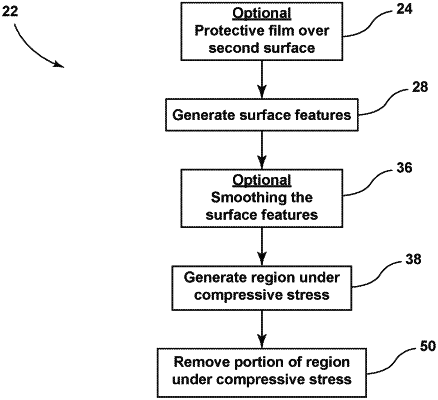| CPC C03C 15/02 (2013.01) [C03C 21/002 (2013.01)] | 20 Claims |

|
1. A method of modifying a glass substrate comprising:
generating a glass substrate having a region under compressive stress from a first surface to a depth of compression (DOC), wherein the first surface has surface features with peaks and valleys, the surface features providing a roughness average (Ra) within the range of 10 nm to 2000 nm; and
removing a portion of the region under compressive stress from the first surface into the depth of compression to define a new first surface still having surface features with peaks and valleys providing a roughness average (Ra) within the range of 10 nm to 2000 nm,
wherein, the removing the portion of the region under compressive stress from the first surface into the depth of compression to define the new first surface comprises contacting the first surface with a light etchant that is a liquid comprising hydrofluoric acid within a range of 1 wt % to 5 wt % or sodium hydroxide within a range of 5 wt % to 50 wt %,
wherein, the removing the portion of the region under compressive stress is conducted such that the portion has a thickness within the range of 0.5 μm to 2 μm,
wherein, the contacting is conducted for 30 seconds to 5 minutes with the hydrofluoric acid or at a temperature from 90° C. to 140° C. for 2 minutes to 120 minutes with the sodium hydroxide,
wherein, a change in an arithmetic mean height (Sa) of the surface features measured before and after the removing step is less than 5%, and
further wherein, a change in a haze provided by the first surface measured before, and the new first surface measured after, the removing step is less than 5%.
|